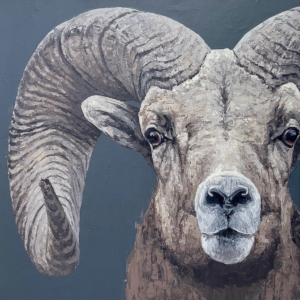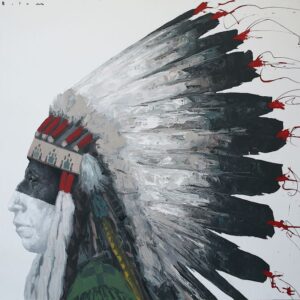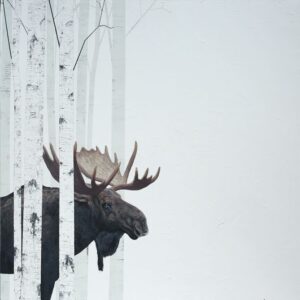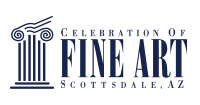Q&A with Andrew:
Artist Andrew Bolam may have been born and raised in Northern England, but his soul seemed to have a deep connection to the American West. In fact, his earliest memories involved lying in front of the TV with a sketchpad while watching Western movies. Everything about the West fascinated him, from the culture to the landscape to the wildlife.
So, it isn’t any surprise that he ended up settling in the West and making it the focus of much of his work. But, like many artists, it took some excavating to unearth that deep-seated calling and trust what his soul was beckoning him to paint. And throughout his career, every time he followed his heart’s calling, it more often than not led to a series of green lights.
More recently, Andrew has been exploring how to tap into some of our primordial human instincts to create an emotional connection with his work as well as how the brain can assemble and make sense of abstract shapes.
In this interview, Andrew shares how his journey as an artist has evolved and how he’s testing the waters with some new concepts.
What inspired you to pursue art as a career?
My earliest childhood memories are drawing. I would lie in front of the TV with a sketch pad and draw. I grew up watching cowboy and Western movies and wildlife documentaries. These, and drawing, fascinated me as a kid. Early in my high school life, I was selected for a special art class. The first day of class, the teacher explained while they had 40 or so people elect to take art, they only took the 12 who looked like they had some sort of talent or aptitude towards art to give them this extra focus. That was really instrumental in my youthful development.
The teacher told us there were 1,600 kids in this school and we were the 12 most talented, and that maybe just one of us might be able to make some kind of career as an artist. I remember thinking, even though I had no indicators, “Oh, it’s going to be me”. That was kind of an instrumental moment in my journey to become an artist.
How did you get your start creating art?
I studied graphic design in college in England. When I came to America––to Southern California––I worked briefly as a graphic designer and a freelance illustrator. But I wasn’t really into it. It wasn’t the thing I dreamed I would grow up to be.
In my mid 20s after floundering in that career, I came to Lake Tahoe and took a job in an art gallery. I grew up in the 1970s, in depressed England, and there weren’t really art galleries. That wasn’t a thing, at least where I grew up. So, I thought I could learn a little bit about how the business worked. I ended up running that gallery for a few years, then just before I turned 30, I opened my own art gallery which was my studio and art gallery. I ran that for 20 years.
What do you find most rewarding about your work?
There’s a saying that the happiest people in the world are the ones who do something all day long and at the end of the day they can see the results of the fruits of their labor. People who make crafts, people who maybe write or create or build things or fix things––when there’s a tangible result from working all day, it gives a deep sense of satisfaction.
As an artist, I think we have that on steroids because not only are we seeing what we’ve done at the end of the day––on most days––but also, if we’re being true to ourselves and painting what we want to paint it, it’s a double whammy. We’re getting to spend the day doing something we love and can see the results of our hard work. It’s probably my favorite thing about my career––I’m just in my little studio amusing myself all day long, having the best time and I get paid to do it.
What is the most challenging?
The first one is this is a fickle business. It has its ups and downs. I never know when the next painting is going to sell. Now, I’ve been incredibly blessed and fortunate that I make a good living and I have supportive galleries that encourage me to do whatever I want to do. But it is scary.
The other challenging part is maintaining that sense of self belief. I still have those days of doubt, usually when I’m having a creative quandary in the studio where I’m trying to do something new or I’m unsure as to what it is that I want to be doing right now––and that can last until I have that breakthrough moment.
How has your work evolved over the years?
As a young guy, I painted with gouache, watercolor, acrylic oil, pastels…I did everything. Early in my career, I worked with oil paint almost exclusively through my mid 40s. Then I started working on a new series that required some layering, textual things and sanding. I called it my ‘modern-day cave painting series’. The ideas that I had really required me to work with acrylic paints. I did a whole series of works on panels with acrylics. That’s when I realized I was so fed up with dealing with oil paints––the toxicity, the smell, the need to wear gloves, etc. I realized I could do a lot with acrylic paint that I couldn’t do with oils.
Early on, I also mostly painted landscapes––postcard-like images of Lake Tahoe. I think a lot of young artists start painting what they think people will buy, which makes sense, but it’s actually kind of the wrong way to approach being an artist. While I was doing that, however, I was traveling extensively around the West on my spring and fall breaks, and I’d come home to the studio and paint landscapes of the desert in Utah, wildlife I’d seen in Yellowstone National Park, rodeo cowboys, and Native American artifacts, pictographs and petroglyphs––sort of on the side. But I just started feeling this pull to paint and draw the things that excited me, and those things, I was finding out, were the things that fascinated me in my childhood.
What are you currently working on?
I’m working on a series that is meant to tap into our fight or flight response. We have an innate ability to recognize silhouettes of animals. Even though there might be a limited amount of information that our eyes are collecting, our gut reaction informs us that this might be a dangerous thing that I’m encountering. And I have a couple of different series that I’ve worked on playing with silhouettes of animals. It’s all about the big graphic shape of the animal, which I’m highlighting in the painting, because we all have this innate ability to emotionally understand what we’re seeing when we are looking at animals, and I’m encouraging viewers to have an emotional connection with the painting. Not everyone’s going to look at it and think like that, but I think there’s an opportunity for people to look at that series and feel something, which is what I’m trying to do.
The other series that I’ve worked on for the last several years is much more about the abstract surface of a painting. I just did a giant painting of a wolf’s face, and from a distance, it’s very, very realistic. Some people would say, from a distance, it looks almost photographic, which is not what I’m doing with my work. But when you get up close, it’s just big shapes of color that have been combined together in such a way so as to become an image of a wolf or to remind you of an image of a wolf. And the idea I have behind that is, again, as a kid growing up I was fascinated by how TVs worked. This was before LED TVs. I’d get right up to the TV and see it was just tiny dots of color and little cathode ray color tubes that would be yellow, black or red. Up close, they’re just little pieces of color. Then as you back away from it, it’s the image. It’s a representative of reality. It’s fascinating to me how these three dots of color become every color in the rainbow and become real things. That idea has stuck with me throughout my career––how to turn abstract information into something that appears to be real, and yet it is still just abstract information.
What drew you to the Celebration of Fine Art?
A couple of artist buddies––Bryce Pettit and Matt Sievers––were telling me about it and how great it has been for their careers and how much they enjoy being there. I had never heard of the show, but two different people came out of the woodwork and started telling me about it. Then I was at the Buffalo Bill Show in Cody, Wyoming and my quick-draw painting was purchased by Susan Morrow Potje. The world is so serendipitous sometimes. So, my partner and I decided to visit the show last year, and we were both really impressed––the quality of work that’s there, the fun atmosphere and the environment. It was just one of those things where the universe collided all of these disparate pieces and said ‘Go check out the show.’ And I answered the call.




